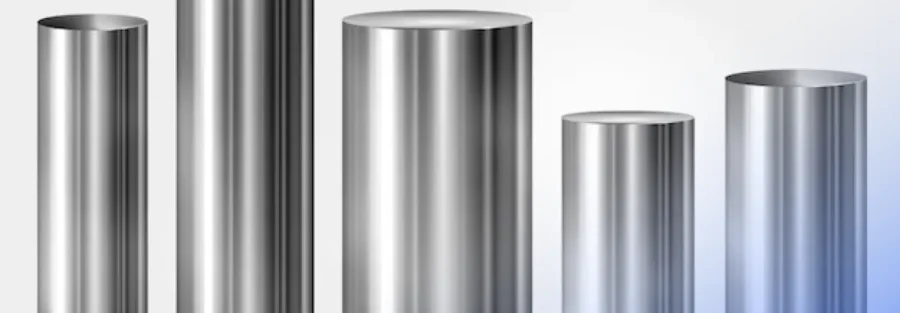In modern manufacturing, material selection plays a crucial role in determining the quality, durability, and performance of products. One standout material in this regard is 17-4 PH stainless steel round bar, known for its exceptional combination of strength, corrosion resistance, and machinability. But how exactly is this versatile alloy used in various manufacturing sectors—and why do industries continue to choose it over others like 15-5 PH or traditional austenitic grades?
This guide explores everything you need to know about 17-4 PH round bars, including their properties, applications, comparison with 15-5 PH, and key considerations for sourcing from stainless steel round bar suppliers.
What Is 17-4 PH Stainless Steel?
17-4 PH, recognised under UNS S17400 and AISI 630, is a martensitic stainless steel known for its precipitation-hardening properties. The “17-4” refers to the alloy composition—17% chromium and 4% nickel, with additions of copper and niobium to enhance hardening and corrosion resistance.
It is heat-treatable to achieve a wide range of mechanical properties, which makes it an ideal choice for high-strength applications where other steels might fail.

Chemical Composition of 17-4 PH (UNS S17400 / AISI 630)
Element | Content (%) |
Chromium (Cr) | 15.0 – 17.5 |
Nickel (Ni) | 3.0 – 5.0 |
Copper (Cu) | 3.0 – 5.0 |
Manganese (Mn) | ≤ 1.0 |
Silicon (Si) | ≤ 1.0 |
Niobium + Tantalum | 0.15 – 0.45 |
Carbon (C) | ≤ 0.07 |
Iron (Fe) | Balance |
This composition of stainless steel round bars supports excellent precipitation hardening, allowing customisation of mechanical properties through heat treatment.
Mechanical Properties of 17-4 PH Stainless Steel Round Bars
Property | Value (H900 Condition) |
Tensile Strength | 1310 MPa (min) |
Yield Strength | 1170 MPa (min) |
Hardness (Rockwell C) | ~44 |
Elongation at Break | 10 – 20% |
Density | 7.75 g/cm³ |
Operating Temperature Limit | ~315°C |
How Are 17-4 PH Round Bars Used in Manufacturing?
Concentric Reducer (Reducer Pipe Concentric)
1. Aerospace & Defence
- Usage: Structural components, shafts, fasteners, landing gear
- Why: The material withstands high stress and temperature while offering reduced weight compared to carbon steel.
2. Medical Devices
- Usage: Orthopaedic implants, surgical instruments
- Why: Its corrosion resistance and biocompatibility make it safe for prolonged exposure to bodily fluids.
3. Automotive and Motorsport
- Usage: Transmission components, drivetrain parts
- Why: Stronger and more durable than standard steel, enabling better performance and reliability.
4. Oil & Gas Industry
- Usage: Valve stems, pump shafts, fasteners, flanges
- Why: High resistance to chloride stress corrosion cracking is essential in offshore and chemical environments.
5. Precision Machining & Tooling
- Usage: Injection mould tooling, jigs, and fixtures
- Why: Offers machinability and hardness for high-precision applications.
17-4 PH vs 15-5 PH Stainless Steel
Property | 17-4 PH | 15-5 PH |
Composition | 17% Cr, 4% Ni | 15% Cr, 5% Ni |
Strength | Very High | Slightly Higher |
Toughness | Good | Better at larger sections |
Weldability | Good | Excellent |
Applications | General purpose | Aerospace, high-performance tools |
Choose 17-4 PH for all-around strength and economy; pick 15-5 PH for critical aerospace and high-precision machining tasks.
Round Bar Sizes and Dimensions
Diameter Range (mm) | Length (m) | Finish Types |
10 – 300 | 1 – 6 | Black, Bright, Peeled, Ground |
Stainless steel round bar suppliers often provide services like custom cutting, heat treatment, and export-grade packaging for various industries.
Where to Find Stainless Steel Round Bar Suppliers?
When sourcing 17-4 PH stainless steel round bars, prioritise the following supplier qualifications:
- ISO 9001:2015 Certified
- Stock of UNS S17400 / AISI 630 bars
- Custom machining capabilities
- Ultrasonic & hardness testing
- MTC (Material Test Certificates)
- Global shipping support
Suppliers in India, UAE, and the USA often serve a wide range of industries, providing cut-to-size bars and heat treatment services per ASTM A564/A693 standards.
Industry Trends: Why Demand for 17-4 PH Is Rising
- Lightweight substitution for carbon and alloy steels in aerospace
- Growth of precision medical devices
- Rise in automated machining requiring strong but machinable metals
- Expansion of chemical and marine sectors with corrosion concerns
Final Thoughts
If you’re searching for a durable, corrosion-resistant, and high-strength round bar material for structural, machining, or load-bearing applications, 17-4 PH stainless steel round bars are an ideal pick. With the right heat treatment, it can outperform other stainless grades in demanding industrial environments.
To ensure product integrity, always work with certified stainless steel round bar suppliers offering full traceability and test documentation.
Equip your manufacturing process with the strength and precision of 17-4 PH round bars, where performance meets reliability.
FAQs
’17’ indicates ~17% chromium, ‘4’ is ~4% nickel, and ‘PH’ stands for Precipitation Hardening, highlighting the exceptional strength of stainless steel round bars.
Both refer to the same material. AISI 630 is the AISI designation, while UNS S17400 is the Unified Numbering System identifier for 17-4 PH stainless steel round bars.
Common conditions include H900, H1025, H1075, and H1150, where the number indicates the ageing temperature in °F, influencing the final hardness and strength of stainless steel round bars.
Yes, it is weldable using standard methods; however, post-weld heat treating is recommended to restore the stainless steel round bar’s corrosion resistance and mechanical properties.
While stainless steel round bars offer good corrosion resistance, they are not commonly used for food-grade applications. Instead, 304 or 316 stainless steel is preferred due to higher non-reactivity with food substances.

